Tag: Visual edit |
|||
| Line 44: | Line 44: | ||
*[[Valtiel]] – represents servitude and loyalty to [[The Order|the Order's]] [[God]]. |
*[[Valtiel]] – represents servitude and loyalty to [[The Order|the Order's]] [[God]]. |
||
*[[Siam]] – represents the helplessness of people and the burdens others have in carrying them, as well as their fate. |
*[[Siam]] – represents the helplessness of people and the burdens others have in carrying them, as well as their fate. |
||
| − | *[[Ghost]]s – represent something particular to [[Walter Sullivan]] of ''Silent Hill 4: The Room'' and the way he killed them. These are very symbolic of Walter and give insight into his true personality. |
+ | *[[Ghost]]s – represent memories of one's actions in the past or something particular to [[Walter Sullivan]] of ''Silent Hill 4: The Room'' and the way he killed them. These are very symbolic of Walter and give insight into his true personality. |
| + | * Split Head - symbolizing illusions and fantasy that becomes "real". |
||
| + | * Void - represents a feeling of guilt that always haunt a person's memory. |
||
Monsters of the ''Silent Hill'' series vary depending on the person that enters the town, though some of them in ''Silent Hill'' and ''Silent Hill: Origins'' are controlled by [[Alessa Gillespie]]. In many cases, the monsters are physical [[Manifestation|manifestations]] of the emotions, guilt, and inner fears that the protagonist or other important characters hold. As the characters progress through the storyline, the monsters become a more threatening and fearsome force. |
Monsters of the ''Silent Hill'' series vary depending on the person that enters the town, though some of them in ''Silent Hill'' and ''Silent Hill: Origins'' are controlled by [[Alessa Gillespie]]. In many cases, the monsters are physical [[Manifestation|manifestations]] of the emotions, guilt, and inner fears that the protagonist or other important characters hold. As the characters progress through the storyline, the monsters become a more threatening and fearsome force. |
||
Revision as of 06:09, 20 December 2014
The Silent Hill series features a broad spectrum of distinctly unique artwork and story set pieces, as well as a variable amount of gameplay styles that have helped define and separate it from and inspire other games in the survival horror/psychological genre.
Aspects of gameplay
Certain gameplay mechanics common to the series include:
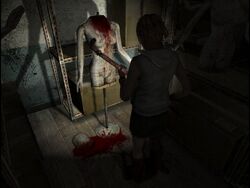
An example of paranormal phenomena in the series.
- Items being placed in random locations for unknown reasons, (ex: lightbulbs in a can, thinner in an elevator, a can opener in a safe, and strangely, ammunition inside classrooms, and toasters in the middle of the streets).
- Respawning of enemies.
- Appearance of enemies (ex: in Brookhaven Hospital, a nurse will suddenly appear behind Heather Mason in a hallway that was free of monsters before).
- Disappearance of enemies (ex: Mannequins in mannequin hallway disappear).
- Paranormal phenomena (ex: monsters, decapitating mannequin, red mist in haunted mansion, etc.).
- Architectural phenomena (ex: Midwich bathrooms, Lakeview Hotel door teleportation).
- Sounds (ex: clanking, groaning, thumps, static (from pocket radio or walkie-talkie to alert the player of monsters), moaning, breathing, sobbing, footsteps, screams).
- Limited resources (ex: a pocket flashlight being the only source of lighting in some areas, breakable weapons, limited ammunition).
- Strange camera angles that create a sense of unease in the player.
Story
Story is an important part of the Silent Hill series, spanning serious and often extremely emotional scenarios in which the characters involved must deal with.
- Themes of love, death and suicide, illness and disease, memory and the human mind, guilt, murder, trying to find happiness, forgiveness, sexual abuse, domestic violence, isolation and loneliness, illusions and delusions, alcoholism, bullying, and children.
- Themes of psychology, existentialism and morality.
- The love between parent and child.
- The love between husband and wife.
- Interconnected stories within separate games.
Music
One of the franchise's most well known features is its remarkably atmospheric, depressing and melancholic soundtrack, composed by Akira Yamaoka from Silent Hill to Silent Hill: Homecoming, and then by Daniel Licht on Silent Hill: Downpour and Silent Hill: Book of Memories.
Composed mainly by repetitive loops of mechanic sounds, most songs of Silent Hill resembles the Industrial genre of music, often with minimalistic structures and prominent percussion.
In Silent Hill 2, Akira Yamaoka opted to do a more melancholic, depressive and atmospheric soundtrack, with more prominent piano/keyboard parts, as shown in tracks like White Noiz, Forest and Promise (Reprise), and some tracks with a more rock/metal oriented sound, like Theme of Laura, Love Psalm, Angel's Thanatos and Overdose Delusion.
From Silent Hill 3 to Silent Hill: Homecoming, most of Silent Hill's music maintained Silent Hill 2 characteristics, but with the addition of vocal songs, with contributions made by Mary Elizabeth McGlynn and Joe Romersa. Some examples of vocal tracks are: You're Not Here and Letter - From the Lost Days from Silent Hill 3, Tender Sugar, Cradle of Forest and Room of Angel from Silent Hill 4: The Room, Shot Down In Flames and O.R.T. from Silent Hill: Origins, Always on My Mind and Hell Frozen Rain from Silent Hill: Shattered Memories, and, finally, One More Soul to the Call and Alex Theme, from Silent Hill: Homecoming.
With the departure of Akira Yamaoka from Konami, the franchise soundtracks were in charge of Daniel Licht (Silent Hill: Downpour and Silent Hill: Book of Memories), and became more "movie oriented", with the addition of more orchestrated compositions, but still maintaining its similarities with past music works. For the first time in the series, a commercial band contributed to the soundtrack, as Korn recorded their song also titled "Silent Hill", which is featured in Silent Hill: Downpour.
Enemies
The monsters of the Silent Hill series are varied in appearance, but all share a common aspect: symbolism. Good examples of this are:
- Pyramid Head – symbolizes judgment, punishment, and wrath.
- Lying Figure – represents internal suffering and the inability to act due to restraint.
- Mandarin or Closer – represent the feeling of being overwhelmed and helpless.
- Nurses – commonly symbolize sexual frustration or fear of medical malpractice.
- Schism – represents a dual nature, split personality and torn psyche.
- Valtiel – represents servitude and loyalty to the Order's God.
- Siam – represents the helplessness of people and the burdens others have in carrying them, as well as their fate.
- Ghosts – represent memories of one's actions in the past or something particular to Walter Sullivan of Silent Hill 4: The Room and the way he killed them. These are very symbolic of Walter and give insight into his true personality.
- Split Head - symbolizing illusions and fantasy that becomes "real".
- Void - represents a feeling of guilt that always haunt a person's memory.
Monsters of the Silent Hill series vary depending on the person that enters the town, though some of them in Silent Hill and Silent Hill: Origins are controlled by Alessa Gillespie. In many cases, the monsters are physical manifestations of the emotions, guilt, and inner fears that the protagonist or other important characters hold. As the characters progress through the storyline, the monsters become a more threatening and fearsome force.
Environments
The environment in the Silent Hill series differs from to game to game, but there are features that continue throughout to create a tense and chilling atmosphere and reference aspects of the fiction.
- Realistic and detailed environments.
- A world which switches between three different versions of the same location:
- Normal World – the actual portrayal of the environment before the character is enveloped in an alternate reality. It is rarely explored through the saga.
- Fog World – a gloomy, depressing alternate reality that at times may appear normal. It is enshrouded in a thick fog that limits the character's vision and conceals distant monsters from view. Buildings appear abandoned and there may be corpses lying in liberal places. This world may also include elements such as snow, rain, or ashes falling from the sky.
- Otherworld – a dangerous, nightmarish world filled with darkness and monsters. The world usually manifests the fears of the characters who see it (in Silent Hill 2, it is made clear that each character sees their own personal version of the Otherworld). Most boss battles take place in the Otherworld. It is usually portrayed as being covered in rust and blood, with metallic and industrial structures. However, some games, (such as Silent Hill 2, Silent Hill 4: The Room, Shattered Memories, and Downpour) show a different portrayal of the Otherworld.
- Ordinary things that seem out of place, such as writings on walls and indecipherable sentences.
- Making the player feel confined in large spaces.
Holes
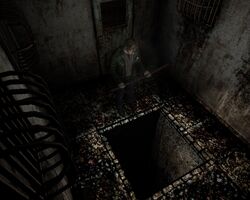
A hole found in Silent Hill 2.
Holes are a recurring theme in the series. Their interpretations range from the simple to the complex, but they usually symbolize characters' inner psyches and the darkness hidden inside their hearts.
Holes first became a prominent theme in Silent Hill 2. Many holes appear throughout the game, some of which James Sunderland actually enters or jumps into. Not all refer to James in particular, but in most cases, they symbolize the act of delving into the inner mind and bringing to light hidden pasts or secrets. This occurs most frequently in the prison and labyrinth, where James constantly descends further by jumping into holes.
Holes in Silent Hill 3 have a significantly different meaning from past games. Here, they symbolize the act of birth and rebirth—both strong motifs in the game. In Heather's case, this would mean the act of birthing God, which is most exemplified by the final hole in the cult church, which leads to the final battle. Unlike the previous game, Heather does not only jump into holes, but climbs up various holes as well.
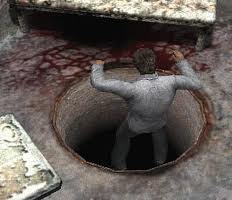
Henry going down through a hole in Silent Hill 4: The Room.
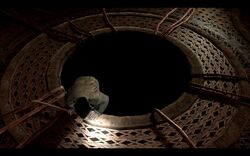
A hole found in Homecoming.
In Silent Hill 4: The Room, Henry Townshend finds a mysterious hole in his bathroom. He enters the hole and finds many strange and eerie worlds. In order to travel back and forth from his apartment to these worlds, he frequently enters and comes out of holes. In the Water Prison World, holes in the floors of various cells are a key component to solving the area's most prominent puzzle.
Holes return as a form of symbolism in Silent Hill: Homecoming where, much like in the second game, they represent Alex Shepherd uncovering his psyche and facing the guilt and delusions he suffers from as he chases after his brother.
Wheelchairs

A wheelchair in Silent Hill 3.
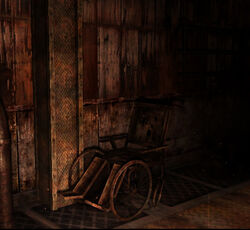
A desolate wheelchair in Silent Hill: Homecoming.
Wheelchairs appear frequently in the series, and have become essential to creating the atmosphere. In most cases, they are placed to create a sense of tension in the player, as they commonly appear in areas where they shouldn't be found.
In Silent Hill, they had a less abstract role, as they represented Alessa Gillespie's hospitalization. This can also be inferred from the many wheelchairs that Heather sees in Silent Hill 3, as she progressively remembers her memories as Alessa. In the beginning of both games, wheelchairs can be seen on their sides with their wheels spinning (i.e. the alley in the first game and the hospital basement in the third game).
In Silent Hill 4: The Room, wheelchairs become enemies. They play a more active role in creating tension, becoming possessed and attacking Henry. In the forest world, Henry finds a doll that is bound in a wheelchair; when its limbs are reattached, the doll comes to life and falls off a ledge. In St. Jerome's Hospital, one room contains an empty wheelchair with a moving shadow. If Henry re-enters the room, the wheelchair will be gone.
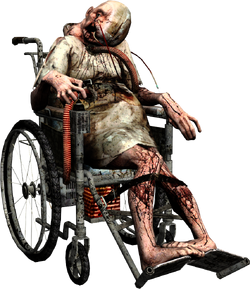
The Wheelman.
In Silent Hill: Downpour, the wheelchair re-emerges as a more frequent and important environmental aspect. Keeping the tradition of previous installments, Murphy encounters a wheelchair at the game's beginning (on the roof of the gas station). The wheelchair, and later its deformed inhabitant, haunt Murphy throughout the game. They collectively represent Murphy's guilt over the debilitations caused by his actions.
In at least one case, the wheelchair also serves as a reference to the film Session 9, which the developers have cited as an inspiration for the series.[1]
Bathrooms and toilets
- Main article: Toilets
Bathrooms and toilets appear in every game in the series, but have subtle reasons to be there beyond being a common real-world location. In-game bathrooms are sometimes important locations, such as in Silent Hill 2, where James starts his journey inside of one. In Silent Hill 3, some of the bathrooms that Heather can enter offer optional interactions, most infamously a bathroom stall that knocks back and then opens to reveal nothing but blood. Bathrooms appear for various reasons and uses, but the horror aspect comes from cultural stigmas.
In Japanese folklore, there exist stories warning children from looking too far into toilets, lest they be pulled in by malicious spirits. Another myth in particular, "Toire no Hanako-san" (or "Miss Hanako of the Toilet") is an urban legend common in elementary schools: it tells of a girl who died inside of a girl's bathroom, and should you knock three times on the third (sometimes fourth) stall of an empty bathroom, she may knock back or even respond verbally.[2] Western folklore can also be inferred as an inspiration for the appearances of bathrooms, with many legends exploiting their sense of confinement and the various murder stories that have taken place within them.
Mirrors
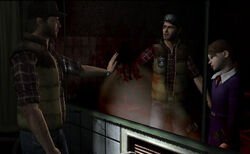
Travis following Alessa's example.
Mirrors appear frequently in each game. Their appearances are mostly due to cultural and urban stigma, but they have also been used to infer another side or a dual meaning to certain things. Generally, mirrors are believed to show things that can't be seen by the naked eye, or reveal the hidden truth behind illusions and evils. Some urban legends, like that of Bloody Mary have also been an inspiration to the unnerving usage of mirrors, specifically the variety found in bathrooms. All of these qualities have been employed in varying degrees in the series.
Silent Hill: Origins takes a more practical approach with mirrors, implementing them as the gateway to the Otherworld. In this sense, however, mirrors also serve to house Alessa's spirit and the "other world" that Helen Grady saw and acted upon.
James and Angela beside a large mirror.
In Silent Hill 2, mirrors are more focused on the individuals that are reflected through them. Two important characters, James and Angela Orosco, are shown before mirrors, bringing to light their repression and the dark secrets that aren't initially apparent.
In Silent Hill 3, mirrors are used to show the inherent darkness living in Heather, and her memory of Alessa manifesting itself. A powerful example of this is the large mirror in the hospital storeroom, which actively changes as Heather looks on, eventually transforming the environment around her. Heather expresses a dislike for mirrors, explaining that she believes her reflection to be an imposter in another world.
In Silent Hill: Homecoming, Alex finds his combat knife embedded in the cracks of a bathroom mirror, along with bloody messages scrawled on it. Significantly, once he retrieves it, the siren blares and the environment flakes away to become the Otherworld.
In Silent Hill: Downpour, Murphy Pendleton is caught with a reflection of the Bogeyman attacking him in a mirror.
Loops and circles
Valtiel rotating a valve (Note: The two pairs of legs also represent Alessa and Cheryl).
Loops often appear to decorate environments in the games. They can be in different forms, including valves, drawn circles and spinning fans. They also appear for various purposes, most notably to symbolize life, rebirth, and self-realization:
- Various valves appear in Silent Hill 3, usually being turned by the creature Valtiel. This symbolizes the rebirth of God, and Heather's life returning to its past life as Alessa. It can also be seen as one world transitioning to another (i.e. the real world into the Otherworld). It may also refer to Valtiel resurrecting Heather so the game can continue every time she dies.
- Fans frequently appear in Silent Hill: Homecoming to symbolize the characters' realization of their psyches and the darkness they harbor in themselves.
- The Halo of the Sun, a prominent cult symbol, exemplifies the meaning of circles in the Silent Hill universe.
Literature, mythology, and the occult
The franchise features many references to works of literature and mythology, as well as occult folklore. This is usually apparent in the many puzzles found in each game. Many of the clues and memos found are also in the form of poems and stories.
- In Silent Hill, The Wizard of Oz is referenced by a set of keys. Alice's Adventures in Wonderland is also referenced in a puzzle among other things.
- Various angels, demons, and spiritual figures have been referenced in the Silent Hill series, including Metatron, Baphomet, and the Olympian Spirits.
- Grimm's Fairy Tales are alluded to in Silent Hill 2 by the music boxes found in the hotel. A small puzzle in Silent Hill 3 also implements the stories of Snow White and Cinderella. In Silent Hill: Downpour, Murphy must solve a puzzle that corresponds with a children's play of Hansel and Gretel.
- The works of Shakespeare act as the key to a certain puzzle in the beginning of Silent Hill 3, are a theme in Silent Hill: Origins (Artaud Theater), and appear in multiple instances in Silent Hill: Shattered Memories.
- Nursery rhymes have been referenced in the games, such as Who Killed Cock Robin?, an English nursery rhyme used for the riddle in the Crematorium Puzzle.
- Janus, the Roman god of gateways and progress, is referenced in an optional puzzle in Silent Hill: Homecoming.
Animals
Dogs
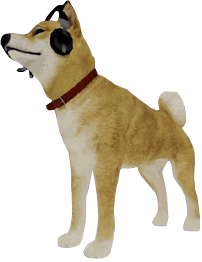
Mira in Silent Hill 2.
- Main article: Dogs
Dogs appear frequently throughout the series, mainly as an archetypal monster. Doghouses have also been implemented, usually in jokes and secrets. Like most of the monsters, they can be attributed as manifestation of characters' fears and emotions.
Mira, a mysterious, possibly extraterrestrial Shiba Inu dog, also appears as a recurring character in some special endings.
Cats
- Main article: Cats
Though not physically manifested as monsters, some cats have actually appeared in-game, while others have a part in either the game's plot or puzzles. For example, in Silent Hill, Harry Mason is at the school and finds a locker rattling as if something is inside. If Harry chooses to open it, a cat will leap out. It is interesting to note that in the Otherworld, the same locker will be empty and covered in blood.
Notes
- ↑ "Book of Lost Memories" Pg 135, Konami Entertainment, 2003
- ↑ Yokai Attack!, The Japanese Monster Survival Guide, Kodansha Int'l. Various additional sources
| Silent Hill games v · e · d | |
|---|---|
| Main series | Silent Hill · 2 · 3 · 4: The Room · Origins · Homecoming · Shattered Memories · Downpour · 2 (Bloober Team) · ƒ |
| Ports / Adaptations | Play Novel · Mobile · HD Collection · Slot machine · Escape · Return |
| Spin-offs | The Arcade · Orphan · Mobile 2 · Mobile 3 · The Escape · Book of Memories · Ascension · The Short Message · Townfall |
| Crossovers | Dead by Daylight: Chapter XVI - Silent Hill · Dark Deception: Monsters & Mortals - Silent Hill |
| Cancelled | Silent Hills (P.T.) · Cancelled projects |
| Production | Konami · Team Silent · Climax Studios · Double Helix · Vatra Games · WayForward Technologies · TAKASAGO · Bloober Team · Annapurna Interactive · HexaDrive |
| Extras | Inspirations · Features · Fonts · Horror Adventure |
